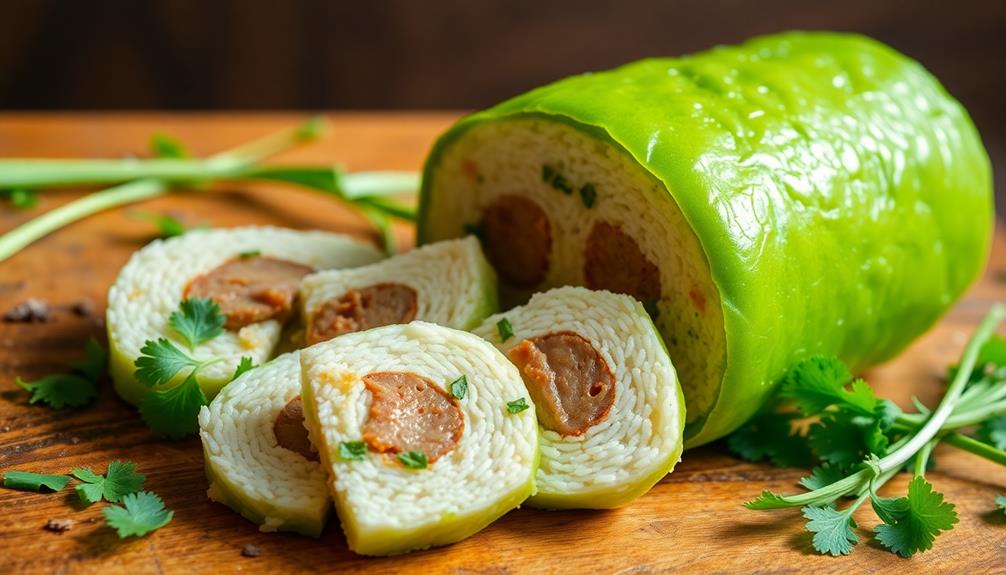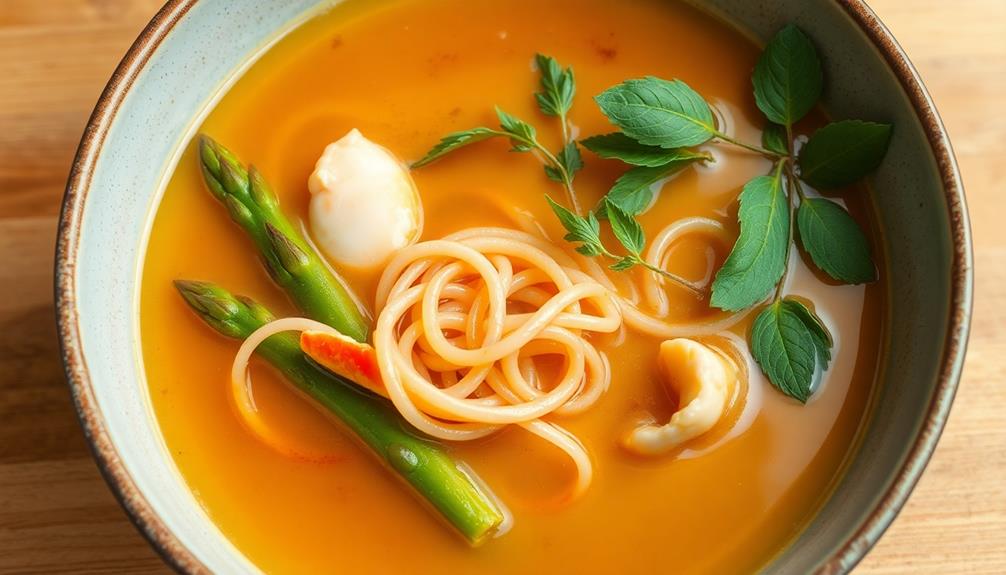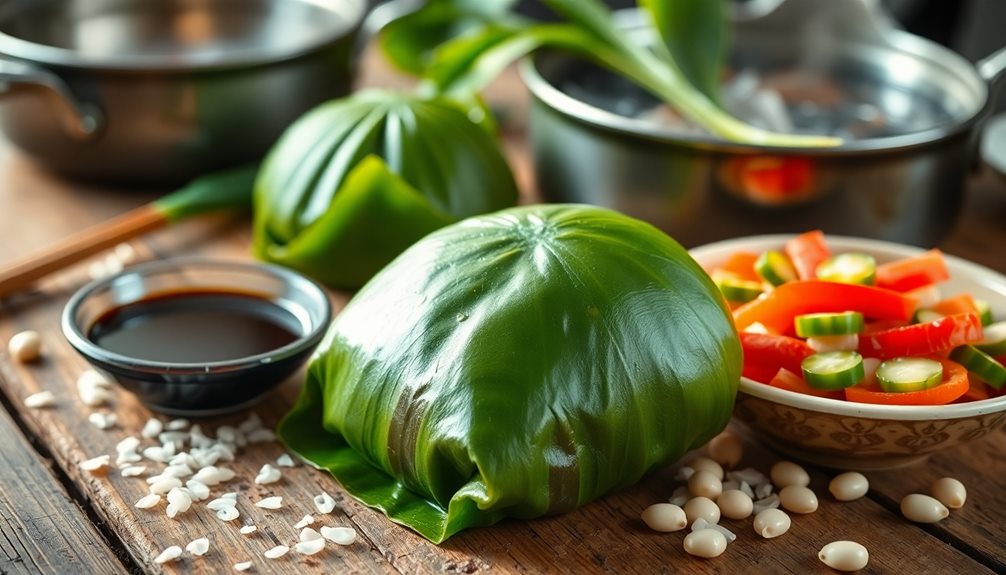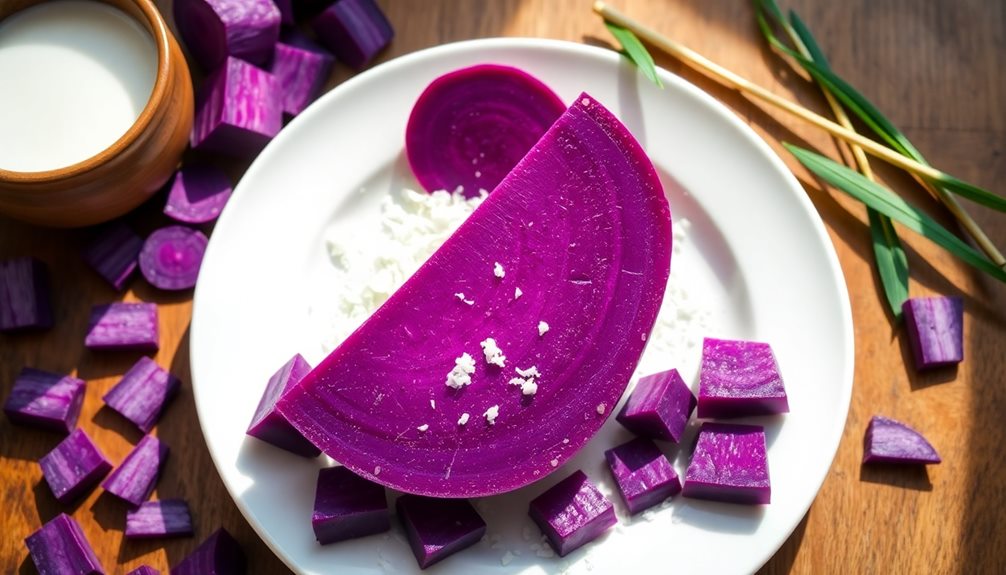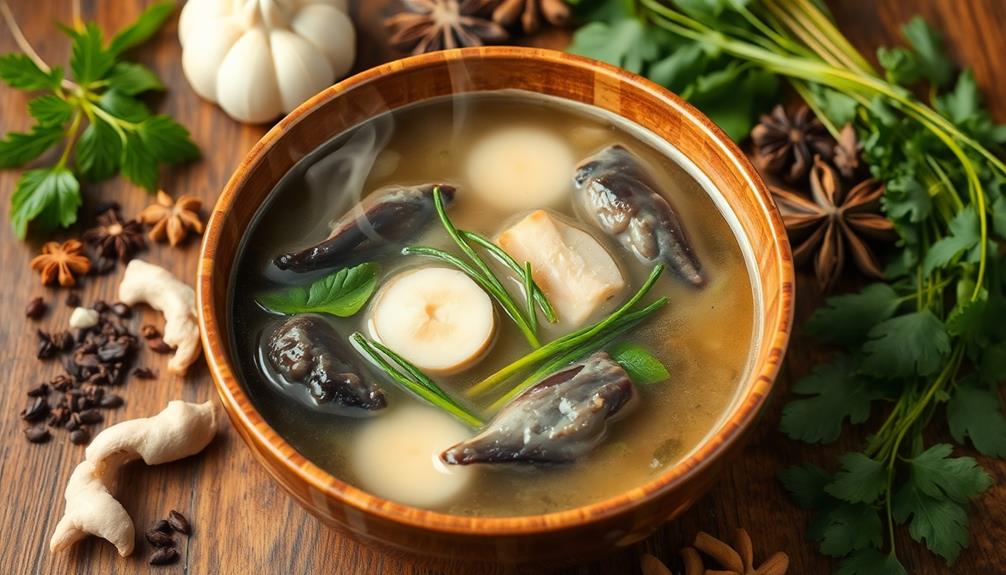The cylindrical sticky rice cake, known as "banh tet" in Vietnam and "nian gao" in China, is a cherished tradition that's been around for centuries. It symbolizes the harmony and unity of Asian cultures with its beautiful shape. To make this delicious treat, you'll start by soaking sticky rice, then mixing it with tasty fillings like mung beans or pork. The wrapped parcels are boiled for two hours, leaving you with a soft, chewy cake that's bursting with sweet and savory flavors. Topped with shredded coconut or syrup, it's a true delight for the senses. Want to learn more about this cultural treasure?
Key Takeaways
- Cylindrical sticky rice cakes, known as "banh tet" in Vietnam and "nian gao" in China, have a rich cultural history representing family unity and traditions.
- These cakes are made from glutinous rice flour, water, and fillings like mung beans or pork, requiring soaking and steaming or boiling for about 2 hours.
- The cylindrical shape and banana leaf wrapping add unique flavors and aromas, creating a delightful sensory experience with a soft, chewy texture.
- Regional variations in fillings and preparation methods exist, each reflecting local ingredients and traditions, contributing to the cultural diversity of the dish.
- Cylindrical sticky rice cakes provide a source of carbohydrates and protein, and can be enjoyed in moderation as part of a balanced diet.
History
Cylindrical sticky rice cakes have a rich history dating back centuries in many Asian cultures. These delightful treats, often called "banh tet" in Vietnam or "nian gao" in China, have been enjoyed by people for generations.
The cylindrical shape is said to represent harmony and unity, as the continuous form symbolizes the cycle of life.
In Vietnam, banh tet is traditionally prepared during the Lunar New Year, or Tet, to celebrate the arrival of spring. Families gather together to make these sticky rice rolls, wrapping them in banana leaves and tying them with strings.
The process can be quite labor-intensive, but it's a cherished tradition that brings people closer. As you take a bite, you'll discover the soft, chewy texture and the sweet, nutty flavors that have delighted taste buds for centuries.
Whether you're in Asia or enjoying these cakes elsewhere, the history and cultural significance of cylindrical sticky rice cakes make them a truly special treat to savor.
Recipe
Cylindrical Sticky Rice Cake is a traditional dessert found in many Asian cuisines. The unique shape and chewy texture of this dish make it a delightful treat. Typically, it's made by steaming a mixture of glutinous rice flour, water, and other ingredients to create a soft, pliable dough that's then molded into a cylindrical shape.
The process of making Cylindrical Sticky Rice Cake can be time-consuming, but the end result is well worth the effort. The finished cake is often served with a variety of toppings or fillings, such as shredded coconut, sesame seeds, or a sweet syrup.
- Glutinous rice flour
- Water
- Sugar
- Pandan leaves (optional)
- Coconut milk (optional)
In a large bowl, combine the glutinous rice flour and sugar. Gradually add water while kneading the mixture until it forms a smooth, pliable dough. If using pandan leaves, add them to the dough and knead until well incorporated.
Cover the dough and let it rest for 30 minutes.
Divide the dough into equal portions and roll each piece into a cylinder shape. Place the cylinders in a steamer basket and steam for 15-20 minutes, or until the dough is fully cooked and translucent.
Serve the Cylindrical Sticky Rice Cake warm, with desired toppings or fillings. For a richer flavor, you can also add a drizzle of coconut milk to the dish.
Cooking Steps
First, you'll need to soak the glutinous rice overnight.
Once it's soaked, drain and rinse the rice until the water runs clear.
Next, mix the rice with your favorite fillings.
Lastly, wrap the rice mixture in banana leaves and boil the parcels until they're cooked through.
Step 1. Soak Glutinous Rice Overnight

The first step in creating the delectable Cylindrical Sticky Rice Cake is to soak the glutinous rice overnight.
You'll want to grab a large bowl and fill it with the sticky rice. Then, just pour in enough water to cover the rice completely.
Now, let it sit and soak up all that moisture! This process helps soften the rice, making it easier to work with later on.
As the rice soaks, you can go about your day, doing other chores or relaxing.
Just remember to check on it periodically and add more water if needed.
The rice should be fully hydrated and plump by the time you're ready to start assembling your Cylindrical Sticky Rice Cake.
This simple yet crucial step sets the stage for the rest of the recipe, ensuring your cake turns out perfectly tender and delicious.
Step 2. Drain and Rinse the Rice

After letting the glutinous rice soak overnight, it's time to drain and rinse it. Grab a large colander and carefully pour the soaked rice into it. The rice will have swollen up and become nice and plump. Give it a good shake to let the excess water drain out.
Next, run some fresh, cool water over the rice, gently stirring it with your hands. This will wash away any remaining starchiness. Keep rinsing until the water runs clear. You'll notice the grains are now shiny and smooth – they're ready for the next step!
Draining and rinsing the rice is an important part of making perfect banh tet. It ensures the final texture is just right – not too sticky, but still delightfully chewy. With this step complete, you're one step closer to enjoying the sweet, aromatic flavor of homemade cylindrical sticky rice cakes.
Step 3. Mix the Rice With Fillings
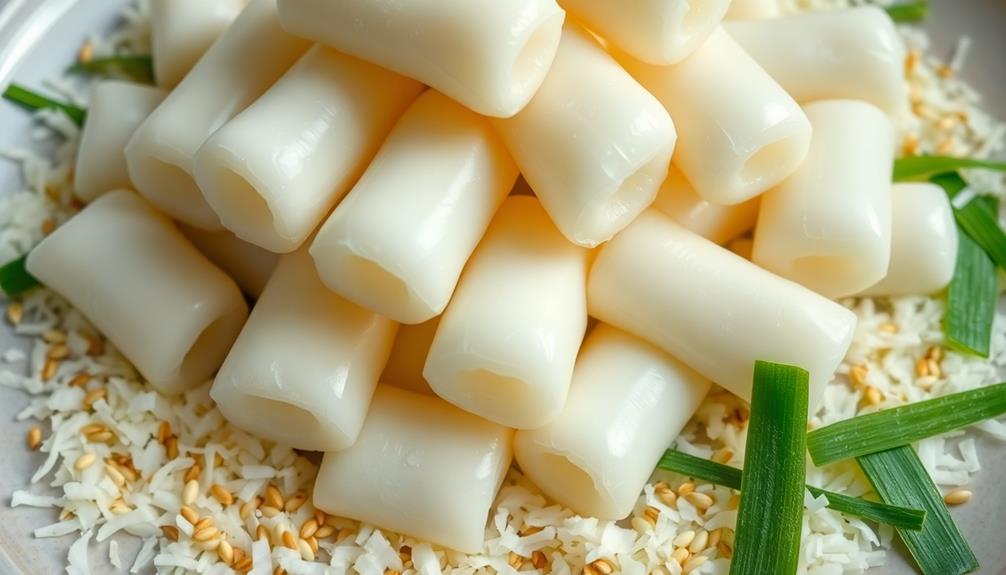
With the rice nicely drained and rinsed, it's time to start mixing in the tasty fillings! First, you'll need to gather up all the yummy ingredients – maybe some delicious mung bean paste, savory pork, or even sweet coconut.
Don't be afraid to get your hands a little sticky as you mix everything together. Knead the rice and fillings until they're perfectly combined, like a big, happy family.
Now, it's time to get rolling! Grab a handful of the rice mixture and shape it into a long, cylindrical roll. Be gentle, but firm, to keep that shape intact. As you work, you can add a sprinkle of salt or a drizzle of coconut milk to keep the rice nice and moist. Once you’ve formed all of your rice rolls, lay them out on a plate or baking sheet and let them chill in the fridge for at least 30 minutes. This will help them firm up and hold their shape when it’s time to cook. While they’re chilling, you can prepare the grilled rice paper recipe by soaking the rice paper sheets in warm water until they’re pliable, then filling them with the rice rolls and any additional fillings or seasonings you like. Then, simply grill the filled rice paper rolls until they’re crisp and golden brown, and enjoy your delicious, homemade Vietnamese-style snack!
Once all your rolls are formed, it's time to wrap them up snug and tight. Grab some banana leaves or parchment paper and tie them up with string to keep everything in place.
Congratulations, you've just made a batch of delicious, homemade banh tet! Get ready to enjoy the sweet, savory flavors of this classic Vietnamese treat.
Step 4. Wrap Rice Mixture in Banana Leaves
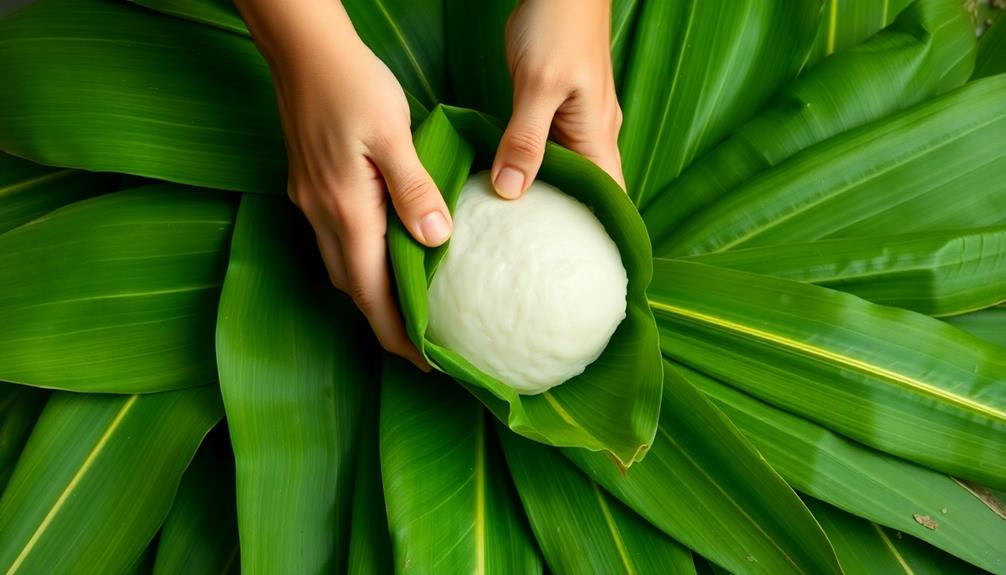
Grab a square piece of fresh banana leaf and place the cylindrical rice roll at the center.
Fold the bottom edge of the leaf over the rice, then tightly wrap the sides around it, forming a neat package. Make sure there are no gaps or openings – you want to seal in all that delicious, savory goodness!
Next, take another leaf and repeat the process, overlapping the edges to create a double layer. This will help the rice cake hold its shape and prevent any leaks.
Gently tie the bundle with kitchen string, securing the ends so it doesn't come undone.
Now you're ready to steam your banh tet! Place the wrapped rice cakes in a large pot with a few inches of water in the bottom.
Cover and let them steam for about an hour, until the rice is tender and cooked through.
Remove them carefully, unwrap, and enjoy this classic Vietnamese treat!
Step 5. Boil Wrapped Parcels Until Cooked
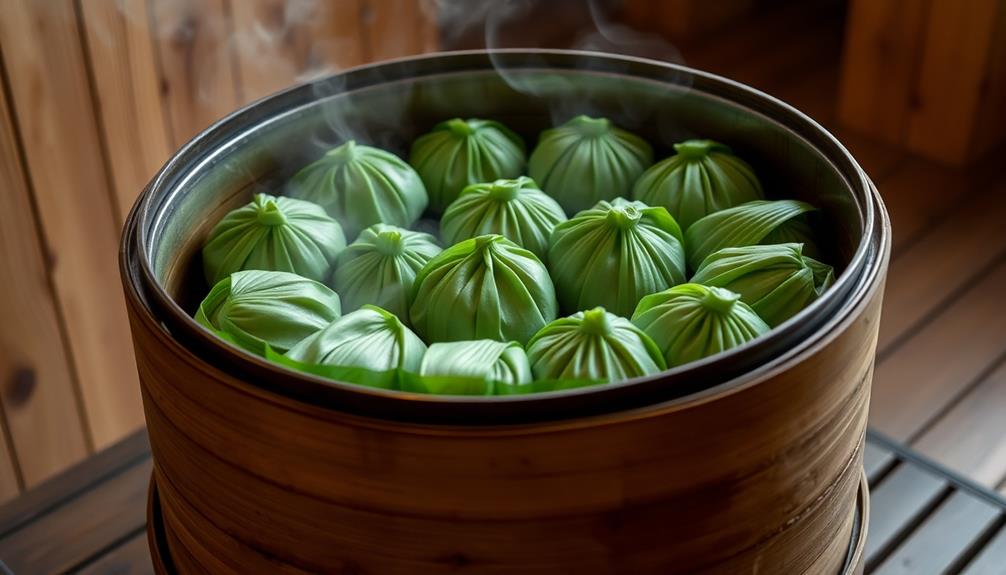
Once the rice cakes are tightly wrapped, it's time to start the cooking process.
Grab your biggest pot and fill it with water, then bring it to a boil over high heat. Gently lower the wrapped parcels into the bubbling water, being careful not to let them unravel. Let them simmer for about 2 hours, checking occasionally to make sure they're staying submerged.
As the parcels cook, you'll start to notice the water taking on a lovely, golden hue – that's the flavors from the rice and fillings seeping out. Mmm, just imagine the delicious aroma filling your kitchen!
When the time is up, carefully remove the parcels from the pot using a pair of tongs. They should feel heavy and solid, a sign that they're perfectly cooked through.
Let the parcels cool for a bit before unwrapping them. Slice them open to reveal the tender, fragrant sticky rice surrounding the tasty fillings.
Grab a napkin and get ready to savor every bite of this classic Vietnamese treat!
Final Thoughts
When it comes to the cylindrical sticky rice cake, you'll find that this traditional delicacy is a true delight for the senses. The sweet, nutty aroma wafts through the air, drawing you in and making your mouth water in anticipation.
As you take that first bite, the soft, chewy texture of the rice cake melts in your mouth, releasing a burst of flavors that dance on your tongue.
The vibrant colors of the cake, often adorned with intricate patterns and decorations, add to the visual appeal, making it a feast for the eyes as well.
Whether you're enjoying it as a snack or as part of a special celebration, the cylindrical sticky rice cake is truly a culinary masterpiece that captures the essence of Vietnamese culture and cuisine.
With each delectable morsel, you'll be transported to a world of rich flavors and warm traditions, leaving you craving for more.
Frequently Asked Questions
How Long Can Banh Tet Be Stored After It's Made?
You can typically store the dish for up to a week if you refrigerate it. It's best to consume it within a few days for optimal freshness and flavor. Proper storage is key to enjoying the dish.
Is Banh Tet Suitable for Vegetarians or Vegans?
Banh Tet is not suitable for vegetarians or vegans as it typically contains pork or other meat ingredients. However, you can find vegan-friendly variants made without any animal products, which would be a suitable option for those following a plant-based diet.
Can Banh Tet Be Frozen for Later Use?
You can certainly freeze banh tet for later use. Just wrap it tightly in plastic or foil, and it'll keep for several months in the freezer. When you're ready to enjoy it, simply thaw it out at room temperature.
What Are Some Popular Variations of Banh Tet?
You'll find many popular variations of this traditional dish. Some common ones include sweet fillings like mung bean, banana, and taro, while savory ones often feature pork, salted egg, or mung bean. The options are endless for customizing this classic treat.
Can Banh Tet Be Purchased Pre-Made or Does It Require Homemade Preparation?
You can find pre-made banh tet at many Asian grocery stores, but the homemade version is often more authentic and flavorful. The preparation process can be time-consuming, so pre-made may be a convenient option for some.
